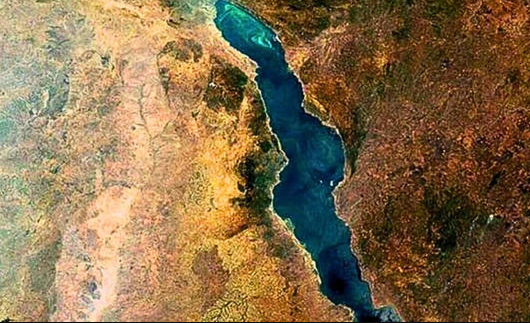East Africa’s Geological Transformation: A New Ocean is Born
East Africa’s Rapid Geological Shift: The Emergence of a New Ocean
East Africa is currently witnessing one of the most fascinating geological processes in the world today: the creation of a new ocean. The East African Rift System, a vast network of fault lines stretching from the Red Sea down to Mozambique, is actively reshaping the continent. What was once considered a geological event that would take tens of millions of years is now expected to unfold at an astonishingly rapid pace—perhaps in as little as a million years or even sooner.
A Slow but Persistent Separation
Beneath the surface of Africa, the African and Somali tectonic plates are slowly pulling apart. The rate of separation may seem modest—around 0.8 centimeters per year—but the cumulative effect of this movement is already being felt, especially in the East African Rift. The land is weakening, and massive cracks are opening in the Earth’s crust, with some of the most dramatic examples visible in the Afar Triangle region of Ethiopia. In this area, a massive rift, extending 60 kilometers in length and reaching depths of 10 meters, has already begun to form, signaling the first signs of the continent being torn apart.
As researchers like Cynthia Ebinger from Tulane University point out, the process is happening much faster than previously anticipated. The once-expected timeline of tens of millions of years has been shortened significantly. This accelerated pace may lead to a much more dynamic geological event, possibly shaped by unforeseen triggers such as earthquakes or volcanic eruptions, which are common in this seismically active region.
The Making of an Ocean: A Rare Phenomenon
The East African Rift is a unique geological feature. It is the only place on Earth where continental crust is actively splitting into oceanic crust. This offers scientists a rare opportunity to witness the birth of an oceanic basin in real time, a phenomenon similar to what occurred when the Atlantic Ocean began forming millions of years ago. The rift, where the African plate is slowly pulling away from the Somali plate, is the birthplace of what will eventually become a new ocean, separating East Africa from the rest of the continent.
In 2005, a significant geological event occurred in Ethiopia that startled the scientific community. Over the course of just a few weeks, more than 420 earthquakes triggered a massive fissure, growing at an astonishing rate. The rift expanded in a matter of days, an event that typically takes centuries to unfold. This rapid change underlined the fact that tectonic shifts are not always gradual, and that the Earth’s geological processes are capable of sudden, dramatic transformations.
Long-Term Impact: Redrawing the Map of Africa
The creation of a new ocean in East Africa will have profound effects on the continent’s geography. As the land continues to separate, it will eventually give rise to new coastlines, altering the political and economic landscapes of the region. For landlocked nations like Zambia and Uganda, access to the ocean could dramatically shift trade routes, opening up new economic opportunities and creating access to international markets.
At the same time, the birth of an ocean will lead to the development of new ecosystems. As water fills the growing rift, a marine environment will begin to emerge, creating new habitats for marine life and changing the biodiversity of the region. The influx of oceanic waters could have a cascading effect on climate patterns, influencing weather systems and regional ecosystems in unpredictable ways.
However, these changes will also present significant challenges. As new coastlines emerge, countries will need to address the infrastructural needs associated with this transformation. Coastal cities and ports will need to be built or expanded to take advantage of new trade routes, while countries will need to plan for the rising sea levels and potential seismic activity that often accompanies tectonic movements. Urban centers and agriculture will also be forced to adapt to shifting landmasses and changing environmental conditions.
A Planet in Motion: Geological Forces at Work
The dramatic events unfolding in East Africa serve as a powerful reminder that our planet is in constant motion. Tectonic forces, which have shaped the Earth for billions of years, continue to drive the evolution of continents, oceans, and the very landscapes we inhabit. As these forces continue to unfold, the world will witness the reshaping of geography on an unprecedented scale.
While the creation of a new ocean in East Africa may seem distant, the ripple effects will be felt far beyond the region. Changes to ecosystems, economies, and even climate patterns will have global consequences, offering a glimpse into a future where continents break apart and new oceans emerge. The work of scientists continues to provide invaluable insights into this process, allowing for better predictions about when and how these transformations will occur. As such, researchers are calling for increased monitoring, data collection, and preparation to understand the full scope of the implications for the people and environments affected by this unprecedented geological event.
Implications for Africa’s Future
As East Africa continues to undergo this tectonic transformation, nations in the region will need to make strategic decisions about how to navigate these changes. The potential for new trade routes and coastal access could offer tremendous economic growth, but it will also require careful planning to ensure sustainability in the face of environmental and infrastructural shifts. Governments must invest in disaster preparedness, strengthen coastal defenses, and work together to address the challenges of an evolving landscape. Understanding and adapting to this shifting world will be crucial as Africa embarks on a new chapter in its geological history.
This ongoing process is not just a curiosity for geologists, but a reminder of the dynamic and ever-changing nature of our planet, where the forces of nature have the power to reshape the world we know.
Also Read:-
Vikrant Massey showed the first glimpse of his son, pictures with his wife went viral
